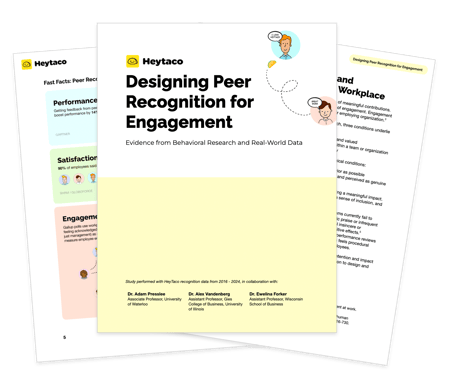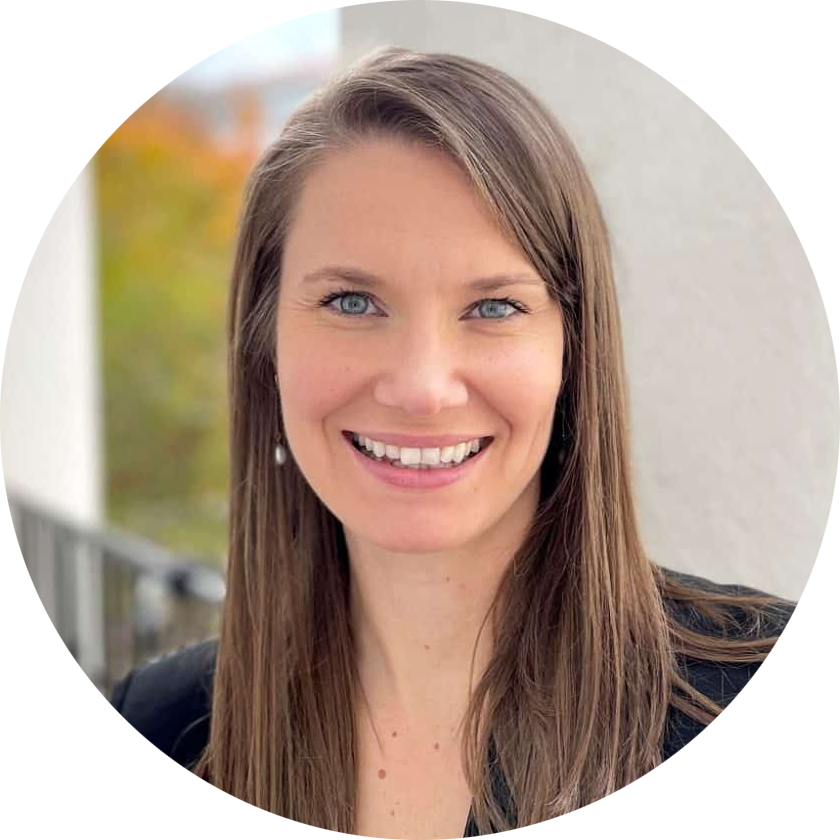White Paper
The Science of Peer Recognition That Boosts Engagement
Based on behavioral science and real-world data from thousands of teams.
Recognition should make people feel valued—not checked off a box. Yet too many programs launch with good intentions only to fizzle out, leaving employees undervalued, recognition feeling hollow, and the link to engagement broken.
That’s why HeyTaco partnered with academic researchers and analyzed anonymized data from over 5,000 organizations worldwide, spanning industries, team sizes, and cultures. By combining behavioral science with nine years of HeyTaco usage data, this paper uncovers the principles that make recognition programs succeed where others fail.
Inside, you’ll learn the psychological needs recognition must satisfy, the design traps that quietly undermine adoption, and the proven practices that transform recognition into a daily habit people love—and leaders notice.

What You’ll Learn
Inside, you’ll discover:
-
The three psychological needs recognition must satisfy to boost engagement (and why most programs miss the mark).
-
Peer recognition myths—busted. Why some well-meaning programs backfire and how to avoid common traps.
-
Rewards that work. How symbolic, dynamic, and personal rewards fuel adoption and retention—and why they don’t undermine intrinsic motivation.
-
The leaderboard trap. The mistake that decreases helping behavior by 21%—and the design choice that increases generosity by 18%.
-
Six evidence-based principles for effective recognition, drawn from psychology and organizational behavior research.
-
Proven results from real-world data:
-
Teams with rewards enabled were 481% more likely to adopt recognition company-wide.
-
Just a 1% increase in recognition activity made teams 90% more likely to stick with it.
-
Teams with “giver” leaderboards sent 25% more recognition per person each month.
-
What This Paper Will Help You Do
This isn’t just theory. You’ll walk away with a practical framework to:
-
Align recognition with your company’s values and culture
-
Create systems that scale across departments, not just pockets of the organization
-
Choose the right rewards and leaderboard settings to sustain momentum
-
Train your people to give meaningful, specific, and sincere recognition
-
Measure and iterate on your program for continuous improvement
With this guidance, you’ll be equipped to design a recognition program that:
-
Builds stronger team cohesion
-
Increases engagement and retention
-
Strengthens prosocial behaviors like helping and feedback
-
Makes recognition a lasting part of your culture—not a passing perk
In collaboration with:

Dr. Adam Presslee
Associate Professor, University of Waterloo
Dr. Adam Presslee is an Associate Professor and the J. Page R. Wadsworth Junior Chair in Accounting and Finance at the School of Accounting and Finance, University of Waterloo. He is the Co-Director of CPA Ontario's Centre for Sustainability Reporting and Performance Management [CSPM].

Dr. Alex Vandenberg
Assistant Professor, Gies College of Business, University of Illinois
Dr. Alex Vandenberg is an Assistant Professor of Accountancy at the Gies College of Business at the University of Illinois Urbana-Champaign. His research focuses on managerial accounting, with an emphasis on performance measurement, incentives, and how accounting information influences decision-making within organizations.

Dr. Ewelina Forker
Assistant Professor, Wisconsin School of Business
Ewelina Forker is an Assistant Professor of Accounting at the Wisconsin School of Business at the University of Wisconsin-Madison. Her research focuses on topics in financial accounting, with particular interest in corporate disclosure, capital markets, and the role of accounting information in investor decision-making.
Ready to bring lasting recognition to your team? Get the free white paper below.
Who Should Read This
This white paper is written for HR leaders, People & Culture teams, and company builders who want recognition to be more than a “nice-to-have.”
If you’re tasked with improving engagement, retaining talent, or creating a culture where people feel valued and motivated, this guide gives you research-backed, actionable insights you can apply immediately.